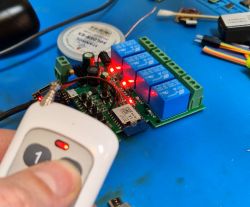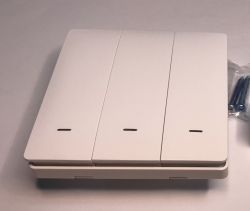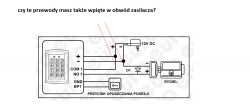FAQ
TL;DR: On the AC‑30C7, the 2 relay outputs are dry contacts—"There will be no voltage on these outputs." Wire your strike’s 12 V through COM–NO/NC to make it open on code or tag. [Elektroda, Anonymous, post #18281958]
Why it matters: This helps DIYers fix “no voltage” on Eura‑Tech AC‑30C7 and correctly wire strikes or gate inputs.
Quick Facts
- NO1/NO2 and NC1/NC2 are dry relay contacts; they switch external power and don’t output voltage. [Elektroda, Anonymous, post #18281958]
- An electric strike needs its own 12 VDC (or matching) power supply; the keypad only controls it. [Elektroda, Anonymous, post #18281976]
- On a valid code or fob, the keypad’s internal relay audibly clicks, confirming contact change. [Elektroda, tedeo1, post #18282009]
- Correct wiring routes the strike’s supply through COM to NO (or NC) to complete the circuit. [Elektroda, Anonymous, post #18282042]
- You can use the dry contact for “mains‑free” triggering of a gate/door controller expecting a short. [Elektroda, Anonymous, post #18282147]
Why is there no voltage on NO1/NO2 or NC1/NC2 of my AC‑30C7?
Those terminals are dry contacts. They don’t provide voltage; they only open or close a circuit. As one expert noted, “There will be no voltage on these outputs.” To open a strike, feed it from a power supply and route one conductor through COM and NO (or NC). When testing, measure continuity across the relay, not voltage. [Elektroda, Anonymous, post #18281958]
How do I wire the AC‑30C7 to power an electric strike?
Use the keypad as a switch in the strike’s supply circuit.
- Connect PSU + to COM, and COM to strike + via NO (or NC).
- Connect PSU – directly to strike –.
- Enter a valid code; the relay closes and completes the strike circuit. This routes power through the relay so the latch releases on activation. [Elektroda, Anonymous, post #18282042]
Do I need a separate power supply for the strike, or can the keypad power it?
Use a dedicated power supply for the strike. The keypad does not source power; it only switches. As the expert put it, “You only have control contacts.” Size the PSU to your strike’s voltage and current, and wire the strike through COM–NO/NC on the keypad. [Elektroda, Anonymous, post #18281976]
Can the code lock trigger my gate without adding mains power?
Yes. Many gate or door controllers accept a dry-contact trigger. Wire the keypad’s COM and NO across the controller’s trigger terminals. The keypad will short those terminals momentarily on valid entry. Do not feed voltage from the keypad into the controller input. [Elektroda, Anonymous, post #18282147]
Can I open the strike from both my intercom and the keypad?
Yes, if you manage the power and control paths correctly. Let the intercom provide the strike’s power. Use the keypad relay to switch that same supply to the strike. Avoid backfeeding between systems; follow each device’s wiring diagram. If unsure, consult a qualified installer. [Elektroda, Anonymous, post #18282063]
The relay clicks but the strike doesn’t open—what should I check?
Verify the strike’s supply is routed through COM–NO/NC, not directly to the strike. Confirm the strike type matches wiring logic (fail‑secure vs fail‑safe). Check PSU voltage under load and polarity for DC strikes. Bypass the relay briefly to confirm the strike actuates on power. If it opens on bypass, the issue is in the control wiring. [Elektroda, Anonymous, post #18282042]
How much current do electric strikes usually draw?
Example: Adams Rite 7100 series draws about 250 mA at 12 VDC. Size your power supply with margin and include all loads on the line. Higher current draws can cause voltage sag and misoperation if the PSU is undersized. [Adams Rite 7100 Series Datasheet]
Which should I use: NO or NC for my strike (fail‑secure vs fail‑safe)?
Use NO for fail‑secure strikes (power to unlock; stay locked on power loss). Use NC for fail‑safe strikes (power to lock; unlock on power loss). Edge case: A fail‑safe strike on NO will drop security during outages. Match wiring to your safety and security policy. [ASSA ABLOY: Electric Strike Basics]
How can I test the AC‑30C7 relay outputs safely?
Set your multimeter to continuity or ohms. Place probes on COM and NO. Enter a valid code; you should hear a click and see continuity. You will not read voltage on those terminals because they are dry contacts. This confirms the relay is switching. [Elektroda, Anonymous, post #18281990]
Can the keypad and strike share the same 12 VDC power supply?
They can, if the PSU has adequate current and clean distribution. Account for strike inrush and keypad load. Many installers prefer dedicated access supplies for reliability and to isolate inductive loads. Add suppression across the strike to reduce interference. [Altronix Access Power Considerations]
What do NO1/NO2 and COM1/COM2 actually represent on the AC‑30C7?
They are two independent relay outputs with common (COM) and switched contacts (NO/NC). Each output controls a separate load, like a gate input or an electric strike. These contacts do not produce voltage; they only connect or disconnect an external circuit. [Elektroda, tedeo1, post #18281939]
How do I protect the keypad relay from inductive kick when switching a strike?
For DC strikes, add a flyback diode across the strike coil (band to +). For AC strikes, use an RC snubber rated for mains or the strike voltage. Suppression reduces arcing, extends relay life, and limits EMI on shared power lines. [ON Semiconductor: Inductive Load Flyback Protection]







